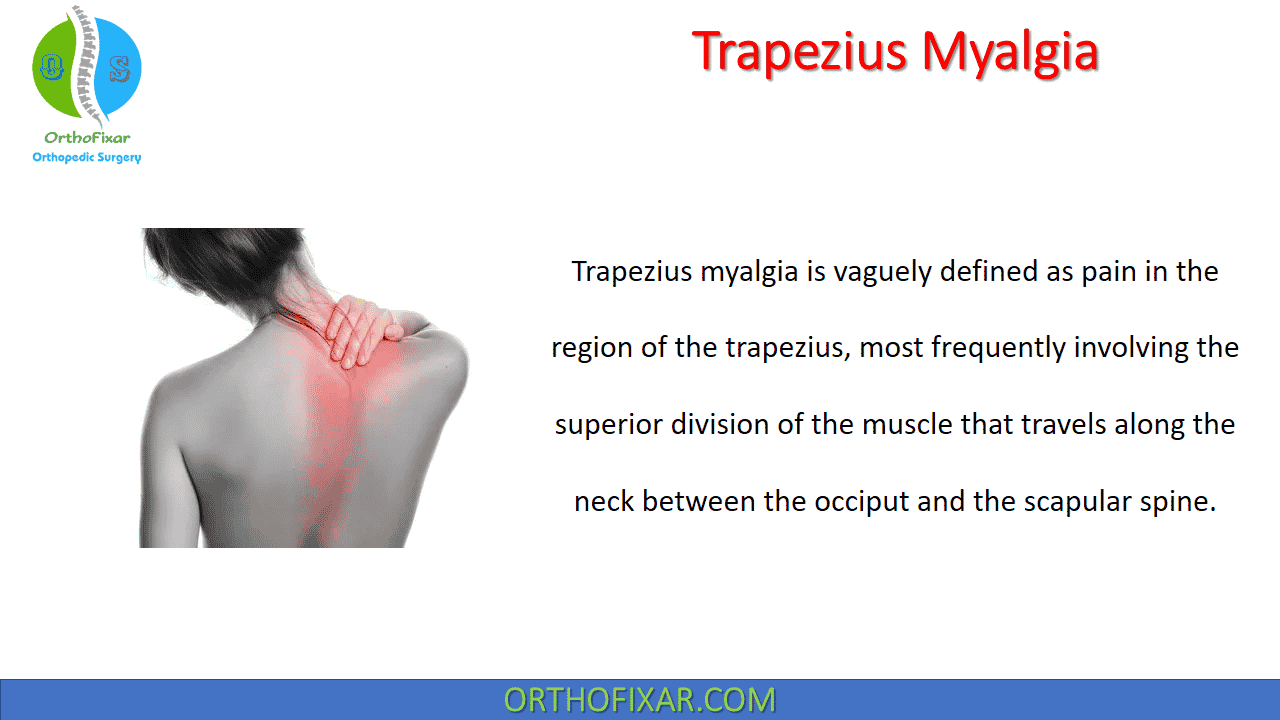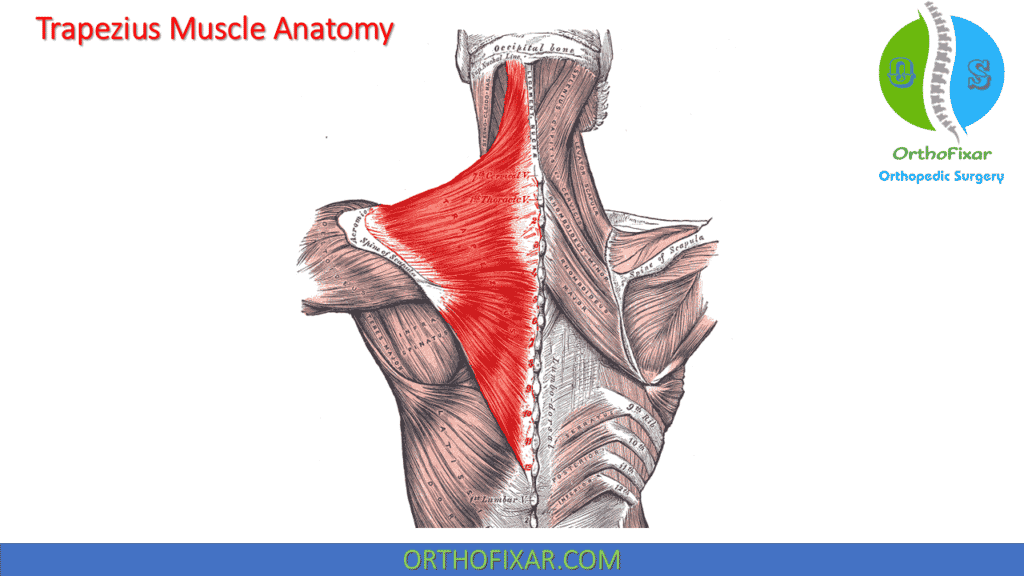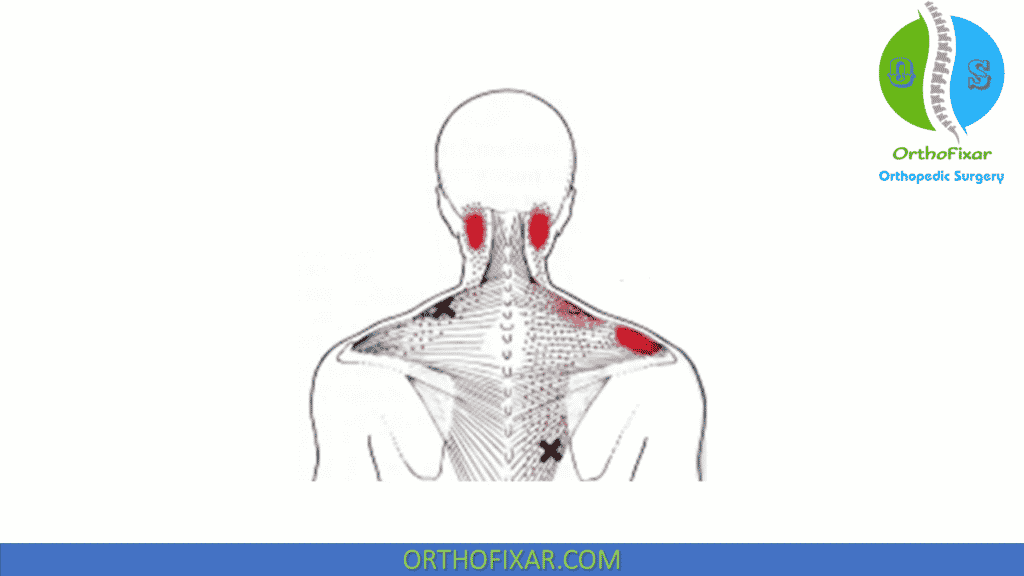Trapezius Myalgia

Trapezius myalgia is vaguely defined as pain in the region of the trapezius, most frequently involving the superior division of the muscle that travels along the neck between the occiput and the scapular spine.
This condition may be association with scapular dyskinesis.
See Also: Scapular Dyskinesis
Trapezius Muscle Anatomy
The trapezius muscle originates from the medial third of the superior nuchal line, the external occipital protuberance, the ligamentum nuchae, the apices of the seventh cervical vertebra, all the thoracic spinous processes, and the supraspinous ligaments of the cervical and thoracic vertebrae.
The upper fibers descend to attach to the lateral third of the posterior border of the clavicle. The middle fibers of the trapezius run horizontally to the medial acromial margin and superior lip of the spine of the scapula. The inferior fibers ascend to attach to an aponeurosis gliding over a smooth triangular surface at the medial end of the spine of the scapula to a tubercle at the scapular lateral apex.
It has been suggested that the upper fibers of this muscle have a different motor supply than that to the middle and lower portions. Recent clinical and anatomical evidence seems to suggest that the spinal accessory nerve provides the most important and consistent motor supply to all portions of the trapezius muscle, and although the C2–4 branches of the cervical plexus are present, no particular elements of innervation within the trapezius have been determined.
One of the functions of the trapezius is to produce shoulder girdle elevation on a fixed cervical spine. For the trapezius to perform its actions, the cervical spine must first be stabilized by the anterior neck flexors to prevent simultaneous occipital extension from occurring. Failure to prevent this occipital extension would allow the head to translate anteriorly, resulting in a decrease in the length, and therefore the efficiency, of the trapezius102 and an increase in the cervical lordosis.
See Also: Scapula Anatomy

Download Human Anatomy Pro for Android Devices:
Trapezius Myalgia Causes
The myalgia probably involves other muscles in the area such as the levator scapulae, the rhomboid major and minor, and/or the paraspinal musculature. The condition is often attributed to poor sitting posture and alterations in the neck flexion angle during prolonged periods of desk- related work.
Symptoms & Signs
Patients typically present with:
- a dull ache,
- tenderness to palpation,
- subjective “tightness” along the lateral side of the neck.
Several studies have identified muscular imbalances, derangements in upper trapezius muscle firing patterns (mostly increased activity), and decreased maximum contraction strength and endurance in this group of patients (i.e., involvement of both fast- and slow-twitch muscle fibers). As a result, many patients with work related neck pain have clinically significant scapular malposition such as decreased posterior tilt and increased protraction which may predispose these individuals to secondary rotator cuff impingement as a result of a decreased acromiohumeral distance.
See Also: Subacromial Impingement Syndrome

A study by Juul-Kristensen et al. confirmed these findings and also noted that patients with trapezius myalgia demonstrated a statistically significant increased capacity for passive glenohumeral internal rotation (due to increased scapular protraction) when compared to normal controls. In addition, those patients who reported the greatest work-related disability associated with trapezius myalgia also demonstrated a 20° increase in passive glenohumeral internal rotation capacity when compared to the rest of the cohort.
Given the very high prevalence of neck pain associated with desk-related work, trapezius myalgia is probably much more common than most physicians and researchers have been able to document to this point. This presumed discrepancy between the reported prevalence and the true prevalence of trapezius myalgia is likely present due to multiple factors.
Most notably, highly accessible media outlets often misinterpret this work-related neck pain as a manifestation of cervical spine pathology. As a result, many afflicted patients likely seek treatment for pain related to the cervical spine rather than the scapula or the shoulder. This misperception may lead patients to undergo expensive, ineffective, and unnecessary treatments such as cervical spine manipulation, injections, and acupuncture, among many other possibilities. Therefore, it is crucial for clinicians of all specialties to recognize the primary and secondary risk factors for trapezius myalgia in order to minimize the effects of misguided communication on clinical outcomes.
Trapezius Myalgia Treatment
Trapezius Myalgia treatment may include:
- Heat,
- Rest,
- Acetaminophen,
- Non-steroidal anti-inflammatory drugs,
- and/or muscle relaxants,
- Physical therapy.
Appropriate Trapezius Myalgia physical therapy should focus on correcting both the acquired muscular imbalance and the hyperkyphotic sitting posture with the ultimate goals of re-establishing normal scapular motion, preventing secondary sequelae (such as rotator cuff disease) and eliminating the patient’s symptoms.
References
- Juul-Kristensen B, Hilt K, Enoch F, Remvig L, Sjøgaard G. Scapular dyskinesis in trapezius myalgia and intraexaminer reproducibility of clinical tests. Physiother Theory Pract. 2011 Oct;27(7):492-502. doi: 10.3109/09593985.2010.528548. Epub 2011 May 6. PMID: 21548819.
- Mercer S, Campbell AH: Motor innervation of the trapezius. J Man Manip Ther 8:18–20, 2000.
- Ayub E: Posture and the upper quarter. In: Donatelli RA, ed. Physical Therapy of the Shoulder, 2nd ed. New York: Churchill Livingstone, 1991:81–90.
- Juul-Kristensen B, Kadefors R, Hansen K, Byström P, Sandsjö L, Sjøgaard G. Clinical signs and physical function in neck and upper extremities among elderly female computer users: the NEW study. Eur J Appl Physiol. 2006;96(2):136–45.
- Ohlsson K, Attewell RG, Johnsson B, Ahlm A, Skerfving S. An assessment of neck and upper extremity disorders by questionnaire and clinical examination. Ergonomics. 1994;37(5):891–7.
- Yoo WG. Changes in pressure pain threshold of the upper trapezius, levator scapular and rhomboid muscles during continuous computer work. J Phys Ther Sci. 2013;25(8):1021–2.
- Andersen LL, Holtermann A, Jorgensen MB, Sjøgaard G. Rapid muscle activation and force capacity in conditions of chronic musculoskeletal pain. Clin Biomech (Bristol, Avon). 2008;23(10): 1237–42.
- Sjøgaard G, Søgaard K, Hermens HJ, Sandsjö L, Läubli T, Thorn S, Vollenbroek-Hutten MM, Sell L, Cristensen H, Klipstein A, Kadefors R, Merletti R. Neuromuscular assessment in elderly workers with and without work related shoulder/neck trouble: the NEW-study design and physiological findings. Eur J Appl Physiol. 2006;96(2):110–21.
- Finley MA, Lee RY. Effect of sitting posture on 3-dimensional scapular kinematics measured by skin-mounted electromagnetic tracking sensors. Arch Phys Med Rehabil. 2003;84(4):563–8.
- Kebaetse M, McClure P, Pratt NA. Thoracic position effect on shoulder range of motion, strength, and three-dimensional scapular kinematics. Arch Phys Med Rehabil. 1999;80(8):945–50.
- Solem-Bertoft E, Thuomas KA, Westerberg CE. The influence of scapular retraction and protraction on the width of the subacromial space. An MRI study. Clin Orthop Relat Res. 1993;296:99–103.
- Lifetime product updates
- Install on one device
- Lifetime product support
- Lifetime product updates
- Install on one device
- Lifetime product support
- Lifetime product updates
- Install on one device
- Lifetime product support
- Lifetime product updates
- Install on one device
- Lifetime product support
